Wasabi!
Authors: Joshua Cappel & Adam Gertzbein
Publisher: Z-Man Games
Year: 2008
review by

| x |
|
|
|
|
|
|
|
|
|
|
|
|
|
|
|
|
|
|
|
|
|
|
|
|
|
|
|
|
|
|
|
|
|
|
|
|
|
|
|
|
|
|
|
|
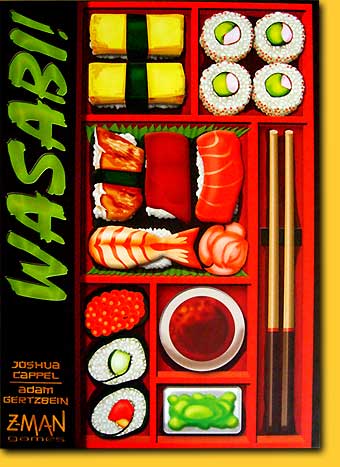 |
Sushi, it is thrown away on us. Little slices of sticky rice wrapped with tough black seaplant that give their taste through spicy salty sauce, served with lukewarm wine; this sure cannot be called a culinairy climax – oh, the visual aspect should also be considered? Food as art? What about my craving appetite?
Sushi, it is nice for the by the local building contractor in the pleasure house of The Rising Sun invitated provincial municipal councillor who will be treated on something eccentric - dining out, he does not make a habit of it, and it is something different from the Schnitzel as big as a dusty door mat he is used to eat in his local diners of the village he rests his head.
|
| x |
|
|
|
|
|
|
|
|
|
|
|
|
|
|
|
|
|
|
|
|
|
|
|
|
|
|
|
|
|
|
|
|
|
|
|
|
|
|
|
|
|
|
|
|
| It is not with reluctance that we sit down to play this game, no, not at all, as we have a large phantasy at our disposal and so we fool ourselves into placing coloured tiles on the game board, preferably in a certain hierarchy because this earns a bonus, but otherwise: no problem either - if only we follow the listed ingredients on the recipes.The game board is an illustration of a cane mat that progressive households with short cash use as a place-mat, but that the Japanese use to tumble the shapeless heap of rice in, to eventually form something esthetically with it. The mat has a grid of six by seven squares that need to be filled with ingredients, one per square. In a two or three player game, a smaller area is used. |
| x |
|
|
|
|
|
|
|
|
|
|
|
|
|
|
|
|
|
|
|
|
|
|
|
|
|
|
|
|
|
|
|
|
|
|
|
|
|
|
|
|
|
|
|
|
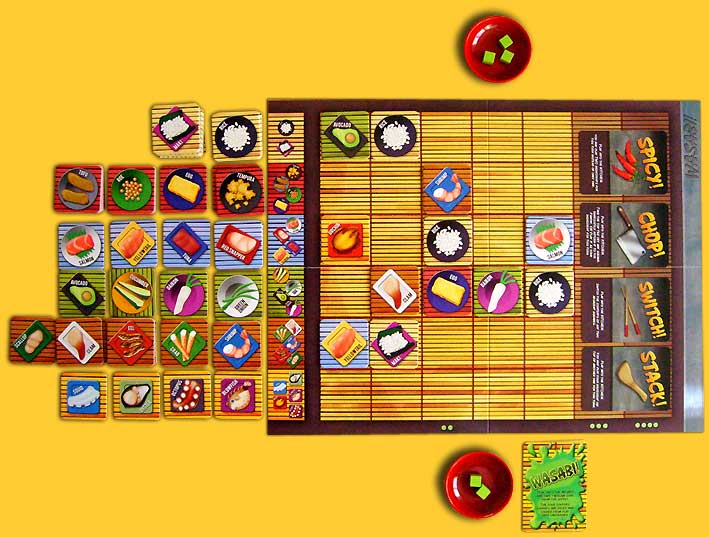 |
| x |
|
|
|
|
|
|
|
|
|
|
|
|
|
|
|
|
|
|
|
|
|
|
|
|
|
|
|
|
|
|
|
|
|
|
|
|
|
|
|
|
|
|
|
|
| Each player is dealt a menu and a little peanut platter where in other cultures wasabi nuts seem to fit in - it is an odd world, and each day new wonders of the world are invented, or at least handsome applications for quite common matters; a man keeps being surprised. |
| x |
|
|
|
|
|
|
|
|
|
|
|
|
|
|
|
|
|
|
|
|
|
|
|
|
|
|
|
|
|
|
|
|
|
|
|
|
|
|
|
|
|
|
|
|
| Three random ingredients are placed behind the menu, and three blindly drawn recipes are placed in the menu. Also, each player has a set of chits that correspond with the various lengths the recipes can have; when he has finished them all he has won the game. The recipes have different numbers of ingredients, from two to five; a player always chooses from which size he wants to draw a new recipe. |
|
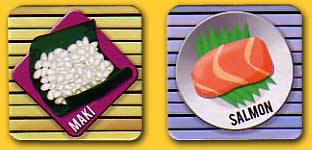 |
| x |
|
|
|
|
|
|
|
|
|
|
|
|
|
|
|
|
|
|
|
|
|
|
|
|
|
|
|
|
|
|
|
|
|
|
|
|
|
|
|
|
|
|
|
|
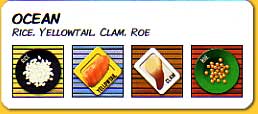 |
|
In a turn, a player places an ingredient on the board, and when all the ingredients of a recipe are adjacent, column or row wise, he claims it. Not all ingredients must have been placed by that player, if only he is the last one to finish it by placing or replacing a tile. If this is the case, he turns one of the corresponding number chits face down - on this side the points for the recipe are shown. When the tiles for a recipe have been placed in the correct order, then the player may take one or more wasabi cubes and place them into his platter - each wasabi cube counts as one point; how many cubes may be taken is stated on the chit for that recipe. After that he refills his hand to three ingredient tiles, and takes a new blind recipe of his choice. |
| x |
|
|
|
|
|
|
|
|
|
|
|
|
|
|
|
|
|
|
|
|
|
|
|
|
|
|
|
|
|
|
|
|
|
|
|
|
|
|
|
|
|
|
|
|
|
When a player has finished a recipe, he also may take one of four action cards. These cards enable a player to move an ingredient, stack it, play two ingredients instead of just one, or entirely remove one ingredient from the board. There also is a wasabi card that is put over four ingredients and effectively covers them until another player finishes a recipe and chooses this action card. Each time when played, the wasabi card earns a wasabi cube, and thus a point.
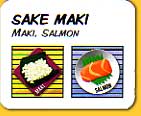
|
|
 |
| x |
|
|
|
|
|
|
|
|
|
|
|
|
|
|
|
|
|
|
|
|
|
|
|
|
|
|
|
|
|
|
|
|
|
|
|
|
|
|
|
|
|
|
|
|
| When a player has finished all his ten recipes, he has won the game, but the game also ends when the board is covered with ingredient tiles; the placed wasabi card covers four squares with or without ingredients. In this case players count the points of their completed recipes and add points for their accumulated wasabi cubes; the player with the highest score wins. |
|
 |
| x |
|
|
|
|
|
|
|
|
|
|
|
|
|
|
|
|
|
|
|
|
|
|
|
|
|
|
|
|
|
|
|
|
|
|
|
|
|
|
|
|
|
|
|
|
| x |
|
|
|
|
|
|
|
|
|
|
|
|
|
| xx |
|
|
|
|
|
|
|
|
|
|
|
|
|
|
|
|
|
|
|
|
|
|
|
|
|
|
|
|
|
|
|
|
|
|
|
|
|
|
|
|
|
|
|
|
 |
|
|
|
|
|
|
|
|
|
|
|
|
|
|
|
|
|
|
|
|
|
|
|
|
|
|
|
|
|
|
|
|
|
|
|
|
|
|
|
|
| ‘Wasabi’ looks really beautiful. Special care has been given to the execution; the platters are not needed but add very well to the atmosphere. This also goes for the menu that holds the recipes in a clever way. To put it somewhat disrespectful: for a simple tile laying game having ‘Four in a Row’ as its roots, there is a lot of fun - but the game also has its tactics. |
|

Hey! I know who did that song! |
| x |
|
|
|
|
|
|
|
|
|
|
|
|
|
|
|
|
|
|
|
|
|
|
|
|
|
|
|
|
|
|
|
|
|
|
|
|
|
|
|
|
|
|
|
|
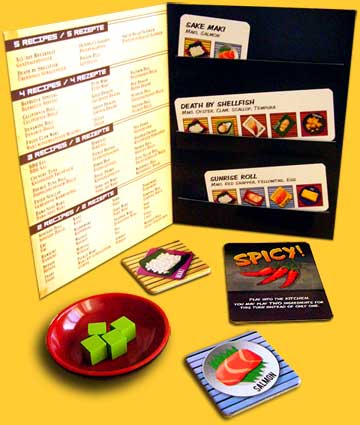 |
|
Each player has a ‘five’ recipe to complete that includes five ingredients. To get these in the right order - if any überhaupt - is almost undoable, but when accomplished it gives eight points ànd three wasabi cubes, eleven whopping points in total.
The action cards give the game its flexibility; no player will want to be without one. The recipes with only two ingredients are easy to complete, but when they all have been completed a player could get stuck: with the larger recipes he cannot that easy earn any action cards as he has done with the simple ‘two’ recipes and this way he might be dependent to the ingredients the other players place. It is therefore advisable to work the recipes in variable size, if possible. |
| x |
|
|
|
|
|
|
|
|
|
|
|
|
|
|
|
|
|
|
|
|
|
|
|
|
|
|
|
|
|
|
|
|
|
|
|
|
|
|
|
|
|
|
|
|
There only is one row in the supply where the‘five’ recipe ingredients are stored; when a player takes one from this row and places it on the board, it is a not to be mistaken signal to the other players: hinder him by placing - or replacing already placed - ingredients that possibly spoil his recipe!
The cards, tiles and rules are in English as well as German, which makes it also convenient for inhabitants of the Home Land of the Board Game.
‘Wasabi!’ is a pleasant and light-hearted in betweenie; just before or after the main course that another game is, this game comes in very handy. And it also goes well with chilled Chardonnay!
© 2008 Richard van Vugt |
|
 |
Wasabi!, Joshua Cappel & Adam Gertzbein, Z-Man Games, 2008 - 2 to 4 players, 10 years and up, 30 to 45 minutes
|
  |
|
|
|
|
|
|
|
|
|
|
|
|
|
|
|
|
|
|
|
|
|
|
|
|
|
|
|
|
|
|
|
|
|
|
|
|
|
|
|
|
  |
|
|
|
|
|
|
|
|
|
|
|
|
|
|
|
|
|
|
|
|
|
|
|
|
|
|
|
|
|
|
|
|
|
|
|
|
|
|
|
|
  |
|
|
|
|
|
|
|
|
|
|
|
|
|
|
|
|
|
|
|
|
|
|
|
|
|
|
|
|
|
|
|
|
|
|
|
|
|
|
|
|
  |
|
|
|
|
|
|
|
|
|
|
|
|
|
|
|
|
|
|
|
|
|
|
|
|
|
|
|
|
|
|
|
|
|
|
|
|
|
|
|
|
  |
|
|
|
|
|
|
|
|
|
|
|
|
|
|
|
|
|
|
|
|
|
|
|
|
|
|
|
|
|
|
|
|
|
|
|
|
|
|
|
|
  |
|
|
|
|
|
|
|
|
|
|
|
|
|
|
|
|
|
|
|
|
|
|
|
|
|
|
|
|
|
|
|
|
|
|
|
|
|
|
|
|
| x |
|
|
|
|
|
|
|
|
|
|
|
|
|
|
|
|
|
|
|
|
|
|
|
|
|
|
|
|
|
|
|
|
|
|
|
|
|
|
|
|
|
|
|
|
| x |
|
|
|
|
|
|
|
|
|
|
|
|
|
|
|
|
|
|
|
|
|
|
|
|
|
|
|
|
|
|
|
|
|
|
|
|
|
|
|
|
|
|
|
|
 |
|
|
|
|
|
|
|
|
|
|
|
|
|
|
|
|
|
|
|
|
|
|
|
|
|
|
|
|
|
|
|
|
|
|
|
|
|
|
|
|
 |
|
|
|
|
|
|
|
|
|
|
|
|
|
|
|
|
|
|
|
|
|
|
|
|
|
|
|
|
|
|
|
|
|
|
|
|
|
|
|
|
| x |
|
|
|
|
|
|
|
|
|
|
|
|
|
|
|
|
|
|
|
|
|
|
|
|
|
|
|
|
|
|
|
|
|
|
|
|
|
|
|
|
|
|
|
|
 |
|
|
|
|
|
|
|
|
|
|
|
|
|
|
|
|
|
|
|
|
|
|
|
|
|
|
|
|
|
|
|
|
 |
|
|
|
|
|
|
|
|
|
|
|
|
|
|
|
|
|
|
|
|
|
|
|
|
|
|
|
|
|
|
|
|
|
|